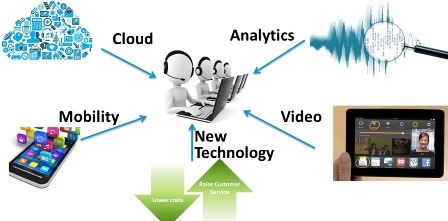
I was recently asked to talk to some of our many contact center customers about the new contact center trends. It struck me that all the trends I’ve seen over the years all pivot around one theme – how to both improve customer service yet also decrease costs. This is not an easy thing to do, yet it’s always lurking in the background with contact centers. And this is one of the reasons, if not the key reason, contact centers embrace new technology. New technology can help you reach both of those seemingly oxymoronic goals. We used to call contact centers call centers. When the Internet arrived, contact centers embraced the Internet as a self-help aspect for the most basic calls. What time are you open? Is my plane on time? What gate is my plane leaving from? VoIP opened up the remote agent possibilities as well as “push to talk”. Speech recognition is also another example that we have come to expect and feel comfortable with today.
As such, new technology, combined with economics, are at the root of many contact center trends. An emerging new technology item is WebRTC. Contact centers need to make sure that they are able to handle WebRTC endpoints calling in. This is what is occurring now. However, WebRTC will also open up new possibilities because an embedded url will enable a call, be it voice or video.
Which brings me to another trend, video. We’ve also seen the Amazon MayDay commercial with Amy where you talk to an agent. I think that is a small use case with video. The bigger possibilities with video in the contact center are as using video as part of the self-help concept. Create short videos to product set up, etc. If you are speaking to an agent, agents can push video to help you, or deliver information to you that might be best delivered by video (like a graph). Video on hold (as opposed to music on hold) could also be interesting. Finally, an agent could potentially see what you see to help with support situations. This could cut down drastically on expensive and frustrating on-site situations – check out the situation first by video, maybe solve it, but if you can’t solve it remotely, then at least when a technician arrived they could be better prepared for the task at hand.
Analytics are also bringing more smarts to the contact center. Over the summer, I wrote a blog about speech analytics. In short, contact centers record all the calls. Doing data mining of various sorts can uncover some key trends about your callers and what they are calling about. This could help contact centers improve the self-help aspects of the contact center, and can help contact centers train their agents better so service is better. Obviously, this is all in the name of reducing costs at the same time.
Mobility is the next key trend I see for the contact center. First of all, many calls are now coming to the contact center from mobile phones. We are seeing many websites adapt and have mobile specific websites in addition to websites for the wired devices – basically small screen vs. large screen website. The same thing applies for calling in from mobile phones. More and more people are opting to use them. I put social media in this category though it could also be its own category as there are some support situations that call for messaging to get out through Facebook and Twitter. Mobile phones also bring much contextual data like location and pictures if that is important and route the call to the best qualified agent. Mobility clearly is a key trend.
Finally, movement to the cloud. And like the other trends above, this is all rooted in utilizing new technology to decrease costs yet also improve customer service. It is estimated that more than two-thirds of organizations today are employing some type of hosted solution as part of their overall contact center solution, with growth over 20 percent. What do cloud-based contact centers bring? For smaller organizations, it eliminates the cost and complexity of your IT having to maintain a CPE-based system, it can allow you to have less upfront costs, it can expand as your business expands and it can get you the latest features more easily.
The contact center will always be a hotbed of innovation because of the needs to both improve customer service while reducing costs. It’s a timeless cycle.








